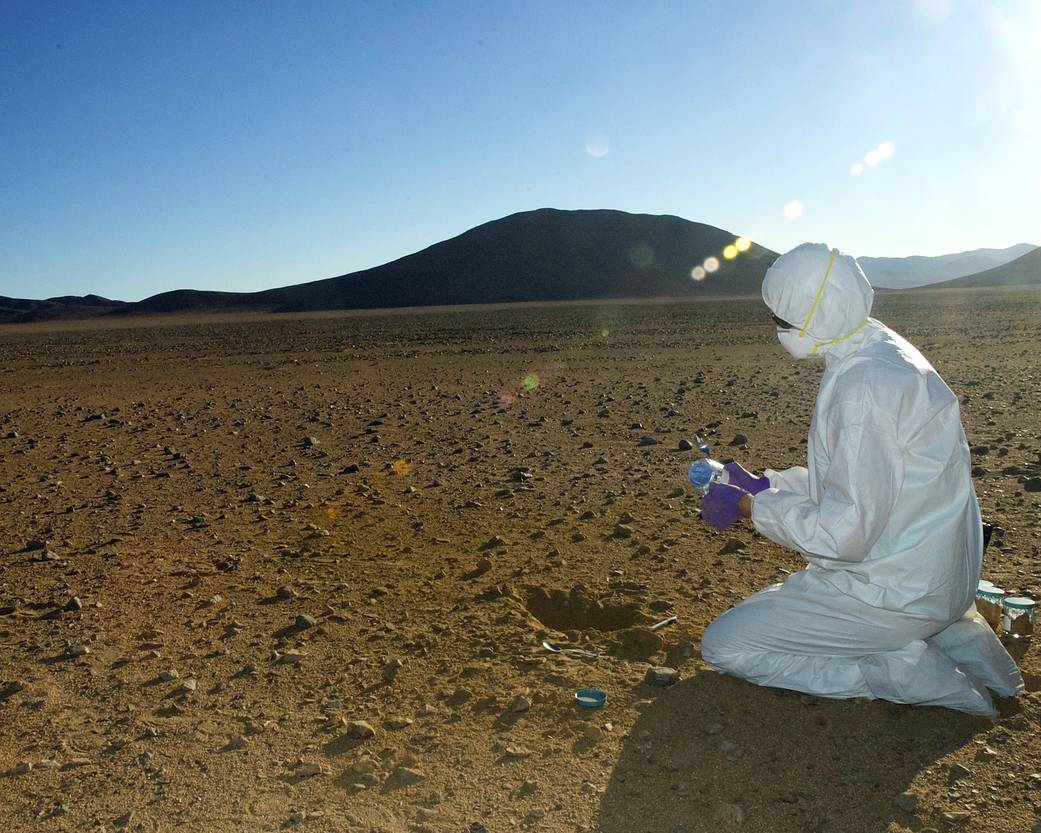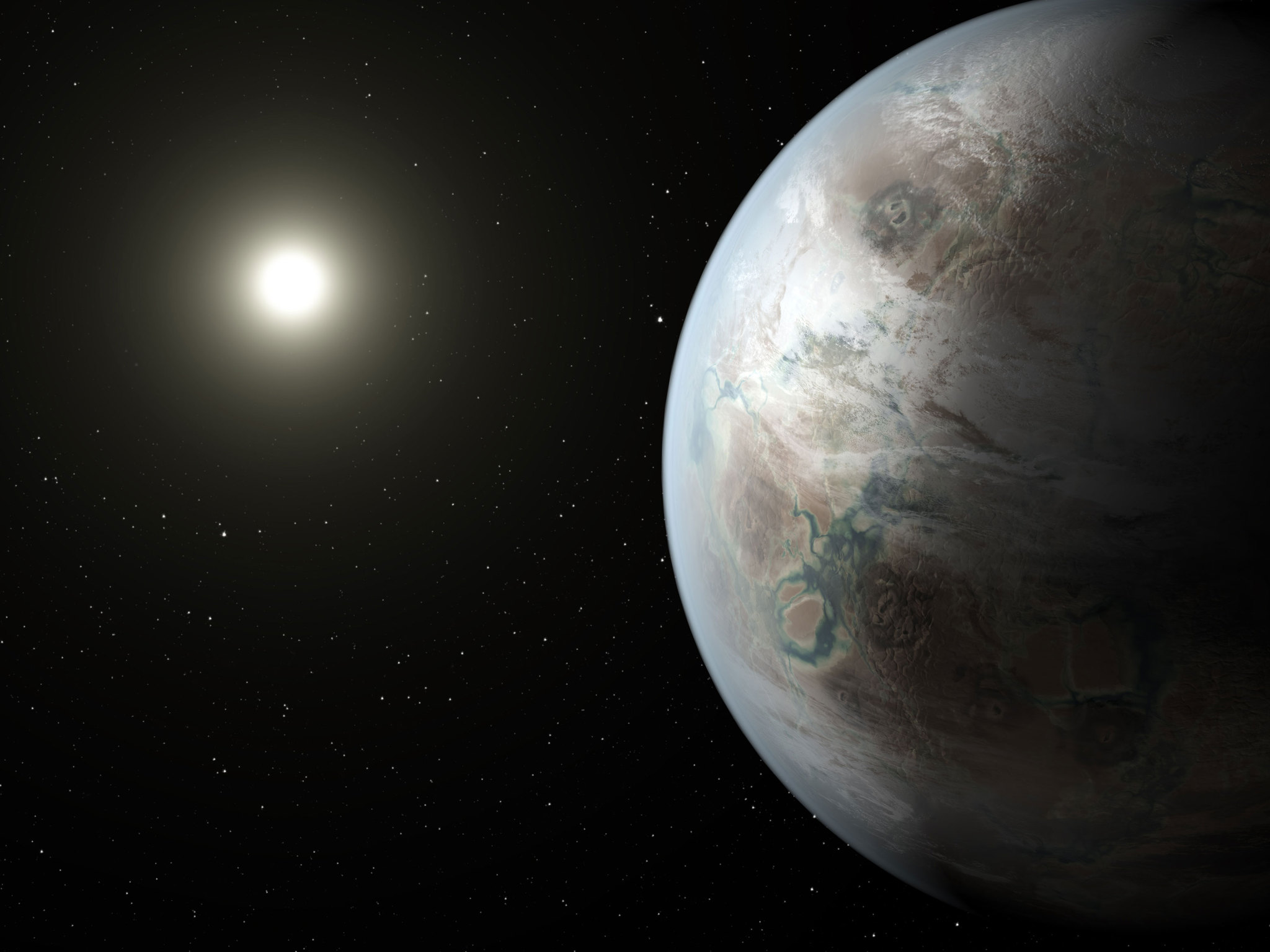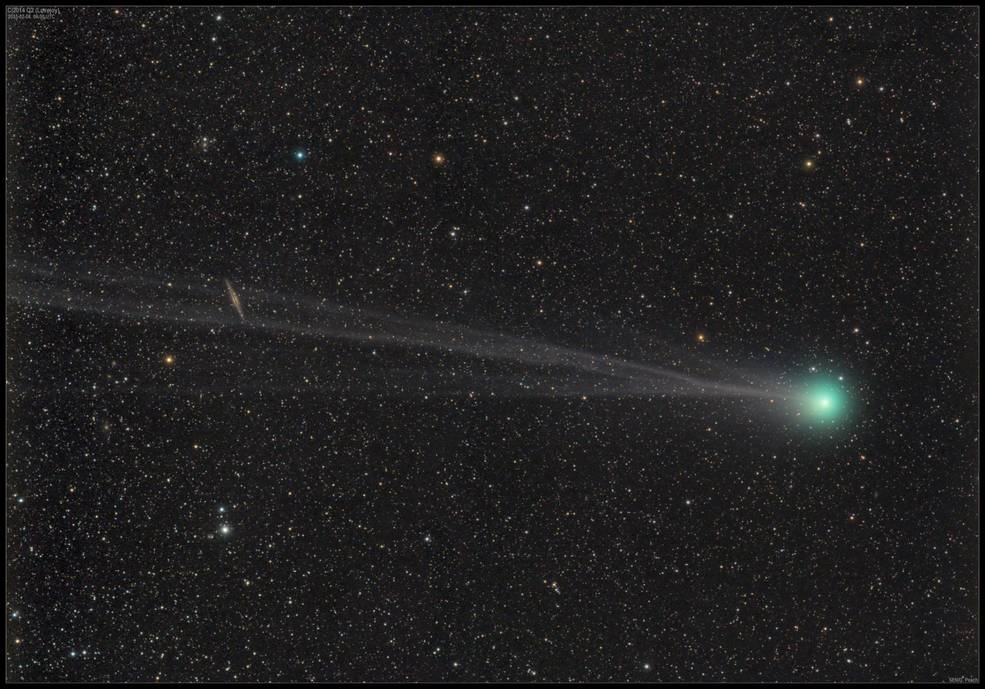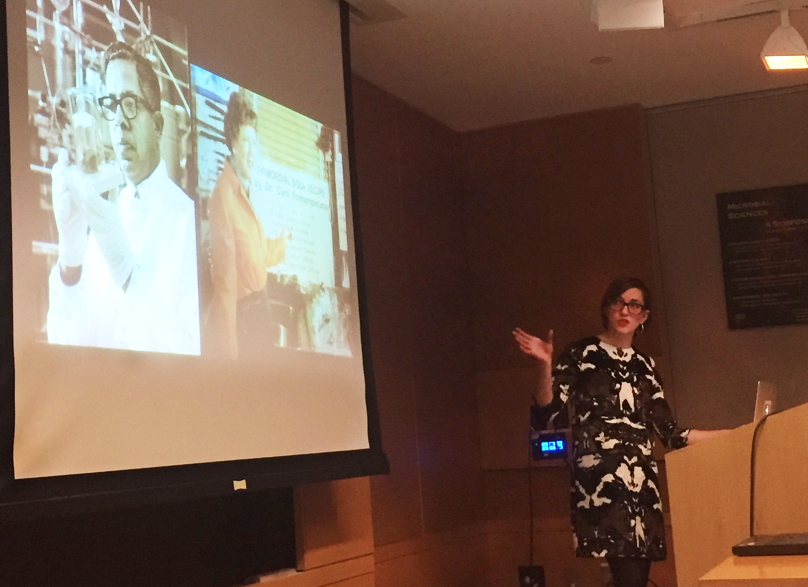Three billion years ago, Earth was a very different place.
-
How Hot Were the Oceans When Life First Evolved?

When haze built up in the atmosphere of Archean Earth, the young planet might have looked like this artist’s interpretation — a pale orange dot.We know little about Earth’s surface temperatures for the first 4 billion years or so of its history. This presents a limitation into research of life’s origins on Earth and also how it might arise on distant worlds as well.
Now researchers suggest that by resurrecting ancient enzymes they could estimate the temperatures in which these organisms likely evolved billions of years ago. The scientists recently published their findings in the journal, Proceedings of the National Academy of Sciences.
“We need a better understanding of not only how life first evolved on Earth, but how life and the ...
Source: [astrobio.net]
June 05, 2017 • Written by: Charles Choi • Report issue
-
AbGradCon 2017 Live Webcast

The Astrobiology Graduate Conference (AbGradCon) 2017 takes place June 5-9, and the webcast will be viewable at SAGANet.org.AbGradCon (Astrobiology Graduate Conference) 2017 takes place June 5-9 and will be webcast in its entirety at SAGANet.org.
View the livestream of AbGradCon 2017.
AbGradCon provides a unique setting for astrobiologically-inclined graduate students and early career researchers to come together to share their research, collaborate, and network. AbGradCon 2017 marks the 13th year of this conference—each time in a different place and organized by a different group of students, but always with the original charter as a guide.
Since it is organized and attended by only graduate students, post docs, and select undergraduates, AbGradCon is an ideal ...
Source: [AbGradCon 2017]
June 02, 2017 • Posted by: Miki Huynh • Report issue
-
Early Career Astrobiologist Profile: How Kennda Lynch Creates a Career in Astrobiology

Lynch examining microbial mats in the Pilot Valley Basin, a paleolake basin in Utah. Photo credit: NASA Astrobiology InstituteIn May, the University of Illinois at Urbana-Champaign profiled Kennda Lynch, postdoc and member of the NASA Astrobiology Institute team at Georgia Tech, tracing how she’s grown from an engineering major at Illinois to become a multidisciplinary researcher in the NASA astrobiology community.
Lynch describes how her emerging fascination with astrobiology combined with opportunity, setting her on a path where she currently researches Mars analog environments found in Utah, work that helps NASA narrow down potential landing sites for the Mars 2020 rover and informs future Mars human missions.
Read the full story at the Engineering at Illinois website.
Source: [UIUC Engineering]
June 02, 2017 • Posted by: Miki Huynh • Report issue
-
Watch Astrobiology Science Conference (AbSciCon) 2017 on YouTube

The Astrobiology Science Conference (AbSciCon) took place at the Mesa Convention Center in Mesa, Arizona on April 24–28, 2017.
Sessions were live streamed, and the recordings of AbSciCon 2017 are now available on the NASA Astrobiology YouTube channel.
The theme this year was “Diverse Life and its Detection on Different Worlds.” Mars and icy worlds in our solar system are increasingly recognized as habitable, even as increasing numbers of exoplanets in their stars’ habitable zones have been discovered. The focus is shifting from identification of habitable worlds, to detection of life on these worlds.
Conference website: http://www.hou ...
May 18, 2017 • Posted by: Miki Huynh • Report issue
-
New Instrument May Aid Search for Extraterrestrial Life

A researcher looks over the Greenland ice cap, a “frozen ocean.” Eleven scientists returned from a field campaign testing an instrument that can scrutinize holes in ice for signs of life. Someday, such an instrument might find its way to Europa or Mars. Credit: NASA/JPL-Caltech/Michael J. MalaskaOcean worlds are on planetary scientists’ minds. More and more, evidence rolls in about the potential habitability of ice-covered bodies like Jupiter’s moon Europa or Saturn’s moon Enceladus. The findings point to heat-driven processes in their subsurface oceans that could support life. Scientists are now beginning to wonder: Could the search for life end on one of these icy satellites?
Assuming humanity does land a spacecraft on Europa or Enceladus, any evidence of life it might uncover would receive heavy scrutiny. In a recent report on a possible landing mission to Europa, scientists devoted multiple chapters to discussing ...
Source: [Eos]
May 16, 2017 • Written by: JoAnna Wendel • Report issue
-
Fossil Preservation in One of the Driest Places on Earth

NASA scientist, Mary Beth Wilhelm, collects soil samples of preserved ancient microorganisms in the Atacama Desert.In the above photo, NASA scientist Mary Beth Wilhelm, wearing a cleanroom suit, kneels as she collects soil samples containing microorganisms from Chile’s Atacama Desert, one of the driest places on the planet. She is investigating the preservation of ancient microorganisms on Earth, and what that might mean for future visits to Mars.
“My research shows that the molecules which made up microbes that lived long ago remain well preserved under extremely dry, Mars-like conditions in the Atacama Desert here on Earth,” said Wilhelm, a researcher at NASA’s Ames Research Center in California’s Silicon Valley, and a ...
Source: [NASA]
May 13, 2017 • Posted by: Miki Huynh • Report issue
-
Student Poster Competition Winners at AbSciCon 2017

The NASA Astrobiology Institute was pleased to once again sponsor the Student Poster Competition at the Astrobiology Science Conference (AbSciCon) 2017. As with previous AbSciCon conferences, this event provided motivation, encouragement, and most of all, recognition to astrobiologists of the future.
Thank you to the 85 students and 43 judges that participated in the competition!
The first place poster, with an award of $1000, went to Jacqueline Long from the College of Marine Science, University of South Florida. Her poster was titled: Chlorophyll-f: Earth’s Unseen Production and Habitability Under Red Light.
You can read her abstract at: http://www ...May 04, 2017 • Written by: Julie Fletcher • Report issue
-
Finding Signs of Alien Life Might Be Harder Than We Thought. Here's Why

An artist's conception of planet Kepler-452b, the first near-Earth-sized world to be found in the habitable zone of a star that is similar to our sun.(Inside Science) — It seems like every day that astronomers discover another possibly habitable world, like Proxima Centauri b, our closest exoplanent neighbor, and TRAPPIST-1f, one of seven recently discovered Earth-sized planets orbiting the same star. But don’t prepare for first contact just yet. It will be exceedingly complicated to figure out whether there’s actually any life or potential for it on such planets, based on new research into our own evolving world.
To a distant observer peering through a telescope, even Earth would not have shown signs of life through most of its past. Despite the fact that our ...
Source: [NBC News]
May 02, 2017 • Written by: Ramin Skibba • Report issue
-
Behind the Iron Curtain: How Methane-Making Microbes Kept the Early Earth Warm

Marcus Bray (left), a biology Ph.D. candidate, and Jennifer Glass, assistant professor in the Georgia Institute of Technology’s School of Earth and Atmospheric Sciences and member of the NASA Astrobiology Institute Alternative Earths team, are shown in the laboratory where tiny incubators simulated early Earth conditions. (Credit: Rob Felt, Georgia Tech)For much of its first two billion years, Earth was a very different place: oxygen was scarce, microbial life ruled, and the sun was significantly dimmer than it is today. Yet the rock record shows that vast seas covered much of the early Earth under the faint young sun.
Scientists have long debated what kept those seas from freezing. A popular theory is that potent gases such as methane – with many times more warming power than carbon dioxide – created a thicker greenhouse atmosphere than required to keep water liquid today.
In the absence of oxygen, iron built up in ancient ...
Source: [Georgia Tech]
April 18, 2017 • Written by: Georgia Tech • Report issue
-
NASA Missions Provide New Insights into 'Ocean Worlds' in Our Solar System
We once thought oceans made our planet unique, but we’re now coming to realize that ‘ocean worlds’ are all around us. Video credit: NASATwo veteran NASA missions are providing new details about icy, ocean-bearing moons of Jupiter and Saturn, further heightening the scientific interest of these and other “ocean worlds” in our solar system and beyond. The findings are presented in papers published Thursday by researchers with NASA’s Cassini mission to Saturn and Hubble Space Telescope.
In the papers, Cassini scientists announce that a form of chemical energy that life can feed on appears to exist on ...

This illustration shows Cassini diving through the Enceladus plume in 2015. New ocean world discoveries from Cassini and Hubble will help inform future exploration and the broader search for life beyond Earth. Credits: NASA/JPL-CaltechSource: [NASA]
April 13, 2017 • Written by: NASA • Report issue
-
Microbes Set the Stage For First Animals

Algal bloom in Arctic pond near Tiksi viewed from a Soviet transport helicopter.It is thought that animal life first arose during the Ediacaran Period, between 635 and 541 million years ago, but these organisms bore little resemblance to the animals we know today. That’s led some scientists to believe that they may not have been animals at all, and instead amounted to failed experiments in multi-cellular evolution.
The remains of these odd creatures, most of which have no evidence of a circulatory or digestive system, largely vanished from the rock record at the start of the Cambrian Period, 541 million years ago. Piecing together a picture of the Ediacaran environment is key ...
Source: [astrobio.net]
March 29, 2017 • Written by: Amanda Doyle • Report issue
-
3rd AbSciCon Meeting Mentor Program

The 3rd AbSciCon Meeting Mentor Program takes place Tuesday, April 25, 2017, 7:45AM-1:30PM.We are thrilled to announce the 3rd AbSciCon Meeting Mentor Program! This is an opportunity for AbSciCon attendees to contribute to inspiring the next generation by providing a safe and guided exposure to a very important and integral part of life as a scientist—participating in a major scientific conference. We will pair you with a local high school or community college student for a 1/2-day during AbSciCon (the morning of Tuesday, April 25th). You and your mentee will do everything you would normally do – attend the plenary, converse with colleagues during coffee breaks, attend session talks, chair sessions ...
Source: [AbSciCon 2017]
March 22, 2017 • Written by: Daniella Scalice • Report issue
-
NAI CAN 8 Preproposal Conference - Friday, March 10, 2017

The CAN 8 preproposal conference was held March 10, 2017 at 11AM PST / 2PM EST.A preproposal conference for NASA Astrobiology Institute (NAI) Cooperative Agreement Notice Cycle 8 (CAN 8) was held on March 10, 2017 to provide interested parties the opportunity to better understand the intent, scope, and selection criteria of this CAN.
For slides from the conference and more information and updates on CAN 8, visit: https://nai.nasa.gov/funding/can-8/.
________________________
Solicitation Number: NNH17ZDA003C
CAN Release Date: February 27, 2017
Step-1 Proposal Due: April 12, 2017
Step-2 Proposals Due: July 6, 2017Source: [NASA Astrobiology Institute]
March 08, 2017 • Posted by: Miki Huynh • Report issue
-
NASA Study Hints at Possible Change in Water ‘Fingerprint’ of Comet

Scientists from NASA’s Goddard Center for Astrobiology observed the comet C/2014 Q2 – also called Lovejoy – and made simultaneous measurements of the output of H2O and HDO, a variant form of water. This image of Lovejoy was taken on Feb. 4, 2015 – the same day the team made their observations and just a few days after the comet passed its perihelion, or closest point to the sun. Credits: Courtesy of Damian PeachA trip past the sun may have selectively altered the production of one form of water in a comet – an effect not seen by astronomers before, a new NASA study suggests.
Astronomers from NASA’s Goddard Space Flight Center in Greenbelt, Maryland, observed the Oort cloud comet C/2014 Q2, also called Lovejoy, when it passed near Earth in early 2015. Through NASA’s partnership in the W. M. Keck Observatory on Mauna Kea, Hawaii, the team observed the comet at infrared wavelengths a few days after Lovejoy passed its perihelion – or closest point to the sun.
The team focused ...
Source: [NASA's Goddard Space Flight Center]
March 07, 2017 • Written by: Elizabeth Zubritsky • Report issue
-
Proto-Computation and Proto-Life Workshop
Researchers with backgrounds in chemistry, biology, cultural anthropology, geology, chemical engineering, and design aesthetics gathered at Harvard University during a two-day workshop titled “Proto-computation and Proto-life”. Attendees explored technical and philosophical approaches to assessing the conditions under which matter may ‘compute’ something about its environment, and whether such conditions offer a clue as to the origins of life in our universe.
Sophia Roosth, author of the newly released book Synthetic: How Life got Made opened the workshop with a beguilingly simple question: Is life a pattern or a substance? She presented historical cases wherein life was variously considered as form ...

Sophia Roosth, Associate Professor at Harvard University, presents her talk, “Life Is Not a Natural Kind”. Source: B. KacarSource: [Harvard Origins of Life Initiative]
March 06, 2017 • Written by: Betül Kacar • Report issue



